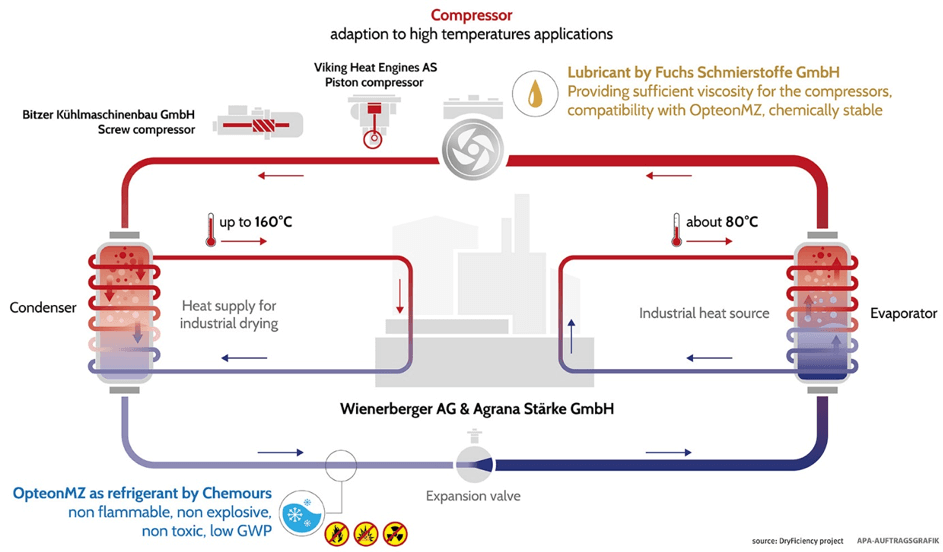CLOSED LOOP HEAT PUMP SYSTEMS IN DRYFICIENCY
Closed loop heat pump systems, also known as compression heat pumps, compress a working media (so called refrigerants) to higher temperature levels at the heat consumer (heat sink) than at the heat source. They deliver a much higher amount of energy (heat) than the amount of energy (usually electricity) needed for their operation. Therefore, they are highly efficient waste heat recovery devices.
Compression heat pumps consist of four main components: compressor, condenser, expansion valve and evaporator. They make use a wide variety of working media (refrigerants), which are kept within a continuous loop at all times (closed loop). In the evaporator, the refrigerant is exposed to the heat source (e.g. industrial waste heat). There, the refrigerant evaporates at low pressure and low temperature. The compressor increases the pressure of the refrigerant to a higher pressure level. In the condenser, the energy of the working fluid (refrigerant) is transferred to a distribution medium (e.g. air) or a heat consumer. The refrigerant is cooled and becomes liquid again. In order to close the heat pump loop, the working fluid is fed into an expansion valve. The low pressure low temperature liquid is ready to enter the evaporator again.
In DryFiciency, high temperature heat pumps achieving heat supply temperatures of up to 160°C were developed and demonstrated first time in industrial environment at TRL7. The DryFiciency consortium worked on several important innovations as shown in the following graph: an advanced lubricant developed by FUCHS, and two novel compressors, one by the Norwegian Heaten, and one by Bitzer Kühlmaschinenbau from Germany. OpteonMZ (or HFO-1336mzz-Z) from Chemours was used as refrigerant. This refrigerant shows favorable characteristics: it is non-flammable, non-toxic and not subject to the F-gas regulation, and proofed well-suited for high temperature applications allowing for heat supply temperatures up to 160°C.

The two closed loop heat pumps demonstrated in DryFiciency are integrated in air drying processes that are currently heated with natural gas. At both industrial sites, waste heat from other drying processes is available. Thus, heat recovery water cycles serve as heat source for the two heat pumps. The heat sink is the drying agent (air), which is heated in a heat exchanger and provides energy for the drying processes. Thus, the natural gas consumption is substituted by a considerably smaller amount of electricity.
More information on the demonstrators is provided here.



